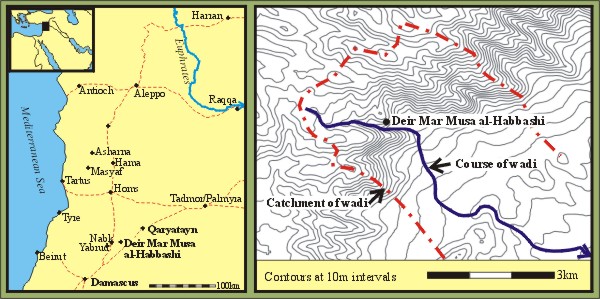![]() Robert B. J. Mason
Robert B. J. Mason
Near and Middle-Eastern Civilizations (NMC)
University of Toronto
|
Near and Middle-Eastern Civilizations (NMC) |
|
University of Toronto - Near and Middle Eastern Civilizations - Mason Home - Unnofficial Mason - Royal Ontario Museum |
|
Deir Mar Musa al-Habashi Archaeology and museum-building at a medieval Syrian monastery
Deir Mar Musa al-Habashi (the monastery of Saint Moses the Abyssinian has stood at the eastern fringes of the
Anti-Lebanon mountains since at least the sixth century. Thought to have been built on the remnants of a Roman watchtower,
today it resembles a storybook castle perched on the edge of a steep precipice overlooking the Syrian desert.

Map showing location of Deir Mar Musa al-Habashi (contour map courtesy of Steven Batiuk)
The first reference to the foundation is in a manuscript dated 586CE that is now in the British Library in London. It is thought that by this time the community was already a thriving Laura in which the monks live in cave-hermitages and return to the monastery in order to pray together. The monastic buildings themselves provide evidence of occupation in subsequent periods. The church itself is typical of the basilical form of the 5th to 6th century, as are motifs carved into the stonework of the church. A period of prosperity in the 11th to 13th centuries is indicated by the renovation of the church in 1058 CE followed by no less than four different levels of frescoes, with the last bearing an inscription dating it to 1192 CE. However it is not until the 15th century CE that there are significant finds of ceramics to give a more thorough understanding of the continuity of occupation of the site, and even this is due to the abandonment of certain rooms, and so represents the beginning of the decline of the monastery. The monastery is certainly known to have been completely abandoned by 1831 CE. The history of the refoundation of the monastery of Mar Musa al-Habashi began in 1982, when a young Italian Jesuit called Fr. Paolo Dall'Oglio was in the area on a retreat, during which he fell off of a cliff, almost dying. In 1984 he began restoration with the aid of volunteers from the local communities and from Europe. In 1991 he completed a Ph.D. in comparative religion and Islamic studies at the Gregoriana in Rome. Within the year he had begun the official foundation, with the monastery in occupation since that date, officially under the aegis of the Syrian Catholic church. Today Deir Mar Musa al-Habashi is actively involved in a wide variety of ecumenical and environmental projects. Standing as it does at the end of a mountain valley leading to the desert, it is in a perfect location to engage with a variety of environmental organisations hoping to reverse the tide of desertification and encourage agro-biodiversity, and the community has been very active in promoting such endeavours. Wadi Deir Mar Musa al-Habashi, the catchment area of the valley itself, is on the verge of becoming a National Park, and the monastic community works in collaboration with the Ministry Commission of the National Park. The National Park will enable environmental and cultural concerns to be married with economic considerations by promoting eco-tourism. All these projects are undertaken in full partnership not only with the Ministry Commission of the National Park, but also the local community. The monastery stresses the importance of both Muslims and Christians from the local society feeling that they have a relationship with the monastic community. Such an emphasis is due to the refoundation of the monastery in the 1980's being overtly intended to act as a focal point of ecumenical interfaith dialogue. The monastic community is exceptionally active in encouraging understanding between Christians and Muslims in a region where such understanding is essential to world peace. Another important aspect of the present situation is the development of the Abraham route, an international initiative for eco-tourism and pilgrimage along a trail that runs from Harran in southeast Turkey, through Syria, and Jordan, to Hebron in Palestine. Both of these monastic sites will be a stations on this route. My involvement with the monastery comprises an archaeological survey of the valley and region, with excavation at selected sites, including some of the caves occupied by the monks in the medieval period. An important aspect of the work of this project is the dissemination of, and interpretation of, information gathered about the long history of the Wadi Deir Mar Musa al-Habashi to the non-academic community. In particular, it is proposed to take seriously the obligations to the local and national communities in Syria and the Middle East at this important pilgrimage sites by constructing a museum. At Deir Mar Musa al-Habashi it will be necessary to create a building specially constructed for the purpose. Official Deir Mar Musa al-Habashi Website Dayr Mar Elian Archaeological Project
Deir Mar Musa al-Habashi
|
|
|
University of Toronto - Near and Middle Eastern Civilizations - Mason Home - Unnofficial Mason - Royal Ontario Museum |